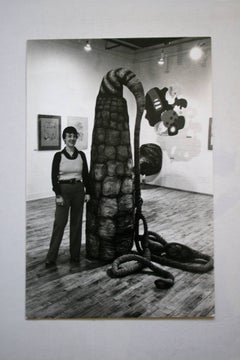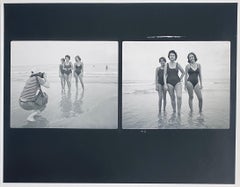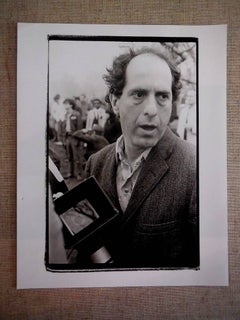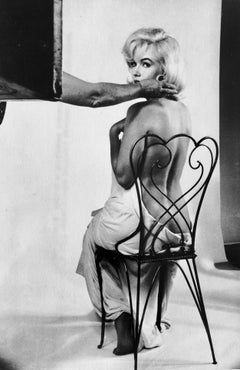Want more images or videos?
Request additional images or videos from the seller
1 of 8
Fred W. McDarrahGillian Bradshaw Smith in Studio1972
1972
$1,200List Price
About the Item
- Creator:Fred W. McDarrah (1926, American)
- Creation Year:1972
- Dimensions:Height: 19.5 in (49.53 cm)Width: 13 in (33.02 cm)
- Movement & Style:
- Period:
- Condition:
- Gallery Location:Surfside, FL
- Reference Number:1stDibs: LU382193802
About the Seller
4.9
Platinum Seller
Premium sellers with a 4.7+ rating and 24-hour response times
Established in 1995
1stDibs seller since 2014
1,815 sales on 1stDibs
Typical response time: 1 hour
Authenticity Guarantee
In the unlikely event there’s an issue with an item’s authenticity, contact us within 1 year for a full refund. DetailsMoney-Back Guarantee
If your item is not as described, is damaged in transit, or does not arrive, contact us within 7 days for a full refund. Details24-Hour Cancellation
You have a 24-hour grace period in which to reconsider your purchase, with no questions asked.Vetted Professional Sellers
Our world-class sellers must adhere to strict standards for service and quality, maintaining the integrity of our listings.Price-Match Guarantee
If you find that a seller listed the same item for a lower price elsewhere, we’ll match it.Trusted Global Delivery
Our best-in-class carrier network provides specialized shipping options worldwide, including custom delivery.You May Also Like
5PTZ Boogie by street art photographer boogieREZ - REZ ONES, layered photography
Located in Jersey City, NJ
5PTZ Boogie by street art photographer boogieREZ - REZ ONES, layered photography
A layered portrait photograph of a graffiti writer (BOOGIErez aka Riiisa Boogie) standing perpendicu...
Category
2010s Street Art Color Photography
Materials
Metal
Price Upon Request
H 16 in W 20 in D 0.75 in
Stormy Daniel's Supreme Tee Shirt Collaboration with Richard Prince Politics
By Richard Prince
Located in Draper, UT
Supreme collaboration with Richard Prince. The tee — titled “18 & Stormy” — features a composite of Stormy Daniels and the other 18 women who have accused President Donald Trump of s...
Category
2010s Street Art More Art
Materials
Cotton
$650
H 29.75 in W 24.75 in D 34.75 in
Mali Kid Legs
By Hassan Hajjaj
Located in Saint Louis, MO
Hassan Hajjaj
Mali Kid Legs, 2014
Metallic Lambda print on 3mm dibond
40 3/10 x 31 inches (102.4 x 78.7 cm)
Edition 2/5
Category
2010s Street Art Color Photography
Materials
Lambda
Nan Goldin Supreme set of 2 skateboard decks (Nan Goldin Supreme)
By Nan Goldin
Located in NEW YORK, NY
Nan Goldin Supreme Skateboard Decks, 2018 (set of 2):
– Misty and Jimmy Paulette in a taxi, (NYC 1991)
– Nan as a Dominatrix (Cambridge MA 1978)
Set of 2 limited edition Nan Goldin ...
Category
21st Century and Contemporary Street Art Portrait Photography
Materials
Wood, Offset
Black Hippie with Blond Afro, Washington Square Park - Henri Ghent Black Curator
By Mitchell Funk
Located in Miami, FL
In 1969, weekends at Bethesda Fountain were a gathering place for the radical, glamorous, and hip people of the time. Abbie Hoffman and Jerry Rubin were regular speakers there. Po...
Category
1960s Street Art Portrait Photography
Materials
Inkjet, Archival Ink, Archival Paper, Archival Pigment
Spiritual Hare Krishna Central Park, Consciousness is the Original Energy
By Mitchell Funk
Located in Miami, FL
In the early 1970s, Central Park was a center for celebrations and protests. In his image, the Hare Krishnas who are a mystical sect of Hinduism are capt...
Category
1970s Street Art Figurative Photography
Materials
Archival Ink, Archival Paper, Archival Pigment
Figures on the Steps of Bryant Park with Caravaggio Light
By Mitchell Funk
Located in Miami, FL
The ephemeral nature of fleeting light is captured in Kodachrome in this early color photograph taken in 1971.
The work is signed, dated, and numbered 3/15 lower right recto, other s...
Category
1970s Street Art Landscape Photography
Materials
Archival Pigment, Archival Ink, Archival Paper
Untitled (from ROBOTNICS Series)
By Christian Rothmann
Located in Kansas City, MO
Christian Rothmann
ROBOTNICS Series
C-Print
2019
Edition S (Edition of 10)
12 x 8.3 inches (30.5 x 21 cm)
Signed, dated and numbered verso
Other Edition Sizes available:
- Edition M (Edition of 6) 35.4 x 23.6 inches (90 x 60 cm)
- Edition L (Edition of 6) 47.2 x 31.5 inches (120 x 80 cm)
- Edition XL (Edition of 3) 88.8 x 58.8 inches (225 x 150 cm)
PUR - Price Upon Request
--------------
Since 1979 Christian Rothmann had more than 40 solo and 80 group exhibitions worldwide.
Christian Rothmann had guest lectures, residencies, art fairs and biennials in Europe, Japan, USA, Australia and Korea.
Christian Rothmann (born 1954 in Kędzierzyn, Poland ) is a painter, photographer, and graphic artist.
In 1976 he first studied at the “Hochschule für Gestaltung” in Offenbach, Germany and moved to Berlin in 1977, where he graduated in 1983 at the “Hochschule der Künste”. From 1983 to 1995 he taught at the university as a lecturer and as an artist with a focus on screenprinting and American art history. To date, a versatile body of work has been created, which includes not only paintings but also long-standing photo projects, videos, and public art.
Guest lectures, teaching assignments, scholarships and exhibitions regularly lead Rothmann to travel home and abroad.
------------------------
Rothmann's Robots
These creatures date back to another era, and they connect the past and the future. They were found by Christian Rothmann, a Berlin artist, collector and traveler through time and the world: In shops in Germany and Japan, Israel and America, his keen eye picks out objects cast aside by previous generations, but which lend themselves to his own work. In a similar way, he came across a stash of historic toy robots of varied provenance collected by a Berlin gallery owner many years ago. Most of them were screwed and riveted together in the 1960s and 70s by Metal House, a Japanese company that still exists today. In systematically photographing these humanoids made of tin - and later plastic - Rothmann is paraphrasing the idea of appropriation art. Unknown names designed and made the toys, which some five decades on, Rothmann depicts and emblematizes in his extensive photo sequence.
In their photographs of Selim Varol's vast toy collection, his German colleagues Daniel and Geo Fuchs captured both the stereotypical and individual in plastic figures that imitate superheroes which were and still are generally manufactured somewhere in Asia. Christian Rothmann looks his robots deep in their artificially stylized, painted or corrugated eyes - or more aptly, their eye slits - and although each has a certain degree of individuality, the little figures remain unknown to us; they project nothing and are not alter egos. Rothmann trains his lens on their faces and expressions, and thus, his portraits are born. Up extremely close, dust, dents, and rust become visible. In other words, what we see is time-traces of time that has passed since the figures were made, or during their period in a Berlin attic, and - considering that he robots date back to Rothmann's childhood - time lived by the photographer and recipients of his pictures. But unlike dolls, these mechanical robots bear no reference to the ideal of beauty at the time of their manufacture, and their features are in no way modeled on a concrete child's face.
In this art project the robots appear as figures without a context, photographed face-on, cropped in front of a neutral background and reduced to their qualities of form. But beyond the reproduction and documentation a game with surfaces is going on; our view lingers on the outer skin of the object, or on the layer over it. The inside - which can be found beneath - is to an extent metaphysical, occurring inside the observer's mind. Only rarely is there anything to see behind the robot's helmet. When an occasional human face does peer out, it turns the figure into a robot-like protective casing for an astronaut of the future.
If we really stop and think about modern toys, let's say those produced from the mid 20th century, when Disney and Marvel films were already stimulating a massive appetite for merchandising, the question must be: do such fantasy and hybrid creatures belong, does something like artificial intelligence already belong to the broader community of humans and animals? It is already a decade or two since the wave of Tamagotchis washed in from Japan, moved children to feed and entertain their newly born electronic chicks in the way they would a real pet, or to run the risk of seeing them die. It was a new form of artificial life, but the relationship between people and machines becomes problematic when the machines or humanoid robots have excellent fine motor skills and artificial intelligence and sensitivity on a par with, or even greater than that of humans. Luckily we have not reached that point yet, even if Hollywood adaptations would have us believe we are not far away.
Rothmann's robots are initially sweet toys, and each toy is known to have a different effect on children and adults. They are conceived by (adult) designers as a means of translating or retelling history or reality through miniature animals, knights, and soldiers. In the case of monsters, mythical creatures, and robots, it is more about creating visions of the future and parallel worlds. Certainly, since the success of fantasy books and films such as Lord of the Rings or The Hobbit, we see the potential for vast enthusiasm for such parallel worlds. Successful computer and online games such as World
of Warcraft, or the creation of avatars are also interesting worldwide phenomena of virtual realities that are not only relevant for children and teens.
So when a middle-aged Berlin photographic artist (like Christian Rothmann) chooses to study 120 toy robots with great difference in form, it represents a journey back to his own childhood - even if at the time, he played with a steam engine rather than a robot. Once batteries had been inserted, some of the largely male or gender-neutral robots, could flash, shoot, turn around and even do more complicated things. Some can even still do it today - albeit clumsily. This, of course, can only be seen on film, but the artist intends to document that as well; to feature the robots in filmic works of art.
The positioning of the figures in the studio is the same as the tableau of pictures in the exhibition room. In this way, one could say Rothmann deploys one robot after the other. This systematic approach enables a comparative view; the extreme enlargement of what are actually small and manageable figures is like the macro vision of insects whose fascinating, sometimes monster-like appearance only becomes visible when they are blown up a hundredfold. The same thing goes for the robots; in miniature form, they seem harmless and cute, but if they were larger than humans and made noises to match, they would seem more threatening.
Some of the tin figures...
Category
2010s Street Art Photography
Materials
C Print
Ahmedabad 151213-84 (India, Street Dancer, Movement, Rhythm, Vibes, 30% OFF)
Located in Kansas City, MO
Lord Fauntleroy
Ahmedabad 151213-84
High Gloss Metal Print
with Float Mount Hanger
Year: 2015
Size: 12 inches diameter
Signed: On Label
Edition: 7
COA provided
Lord Fauntleroy is a ...
Category
2010s Street Art Portrait Photography
Materials
Metal
$522 Sale Price
30% Off
H 1 in Dm 12 in
D. Straker bei der Arbeit (Muralist, Neon, Glow, Graffiti, Street Art)
By Albrecht Fuchs
Located in Kansas City, MO
Albrecht Fuchs
Drew Straker at Work
Giclee on heavy Baryta Rag
2018
24.01 x 18.5 inches (61 x 47 cm)
Edition: 20 - BAT (respectively "Archive")
Signed, da...
Category
2010s Street Art Portrait Prints
Materials
Rag Paper, Giclée
$377 Sale Price
46% Off
H 24.01 in W 18.5 in
More From This Seller
View AllGillian Bradshaw Smith in Studio
By Fred W. McDarrah
Located in Surfside, FL
Gillian was born in India in 1933. Her British parents were part of the twilight of the British Raj.
Gillian completed her secondary education and entered The University of Reading, England to study Fine art and painting, a five year study.
She worked in Dallas, Texas making paintings, creating embroidered wall hangings and teaching special classes. Her work was shown at the Contemporary Gallery.
The art gallery that gave her her most important one man shows was Cordier & Ekstrom on Madison Avenue in New York. Headed by Arne Ekstrom a well known art dealer who showed many noted artists in his gallery including, Isamu Noguchi, Romare Bearden, Richard Lindner, Marcel Duchamp and Man Ray he also fostered the talents of younger artists such as Marvin Israel, Anton Van Dalen and Nancy Grossman...
Category
1970s Street Art Portrait Photography
Materials
Photographic Paper, Silver Gelatin
Vintage Silver Gelatin Photograph Print, Girls on a Beach Photo, Two Man Show
Located in Surfside, FL
Richard Lebowitz, b. 1937, American, (RISD Faculty 1964-1995, Photography; Professor Emeritus)
Tom Young, b. 1951, American, (RISD MFA 1977, Photography)
TIT...
Category
1980s American Modern Black and White Photography
Materials
Photographic Paper, Silver Gelatin
Vintage Silver Gelatin Photograph Robert Frank
By Fred McDarrah
Located in Surfside, FL
Robert Frank in Central Park. Shoot A film during Anti-War protests. April !5 1967
Robert Frank (born November 9, 1924) is an important figure in American photography and film. His m...
Category
1960s Portrait Photography
Materials
Silver Gelatin
Vintage Silver Gelatin Magnum Press Photo Eve Arnold Marilyn Monroe Photograph
By Eve Arnold
Located in Surfside, FL
Marilyn Monroe
Vintage press photo. Photographer Eve Arnold for Magnum Photos. 1962 printed later. (I believe in the early 80's)
Eve Arnold, OBE...
Category
1960s American Modern Black and White Photography
Materials
Silver Gelatin
1986 Red Grooms & Sculpture Vintage C-Print Photograph Abe Frajndlich Colo Photo
Located in Surfside, FL
Abe Frajndlich (German American, b. 1946)
Portrait of Red Grooms
1986
Los Angeles
Hand signed, titled, and dated verso
Abe (Abraham Samuel) Frajndlich was born in a displaced per...
Category
1980s American Modern Portrait Photography
Materials
C Print, Color
Silver Gelatin Photograph Hand Signed Photo Pablo Picasso Arles Lucien Clergue
By Lucien Clergue
Located in Surfside, FL
Lucien Clergue (FRENCH, 1934 - 2014)
Gelatin silver photographic print depicting Pablo Picasso
Picasso Après la Corrida, Arles, 1962.
Hand signed by the artist and numbered 4/30 (e...
Category
20th Century Modern Black and White Photography
Materials
Silver Gelatin
Recently Viewed
View AllMore Ways To Browse
Vintage Animal Toys
Stuffed Toys
Vintage Stuffed Toys
Andy Warhol Jed
Antonio Lopez Tina Chow
Batman Photo
Beach Photography 1970s
Bee Gees
Biggie Smalls
Bye Bye Birdie
Chet Baker Print
Dali Kennedy
David Lee Roth
Eddie Van Halen
Elizabeth Montgomery
Elvis Presley Vintage Photos
George Barris Marilyn
Greg Gorman Michael Jackson



